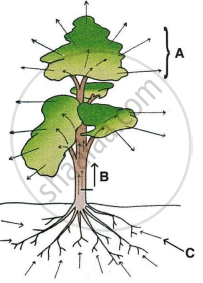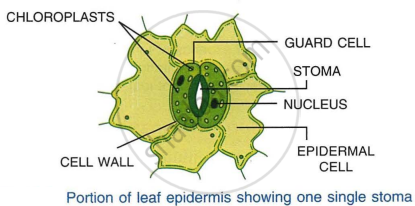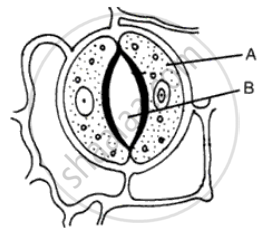Advertisements
Advertisements
Question
An outline sketch of a tree is shown in a diagram below. Study the same and answer the questions that follow:

- Name and define the phenomenon labelled A in the diagram.
- Write the significance of the process mentioned in A for the plants.
- What do the direction of the arrows in B and C indicate? Name the phenomena.
- Draw a neat and labelled diagram of an opened stomata.
Solution
- Transpiration, in plants, is the evaporative loss of water from aerial portions (leaves and stems).
- Significance of transpiration for the plants:
- Cooling effect
- Creating Suction force
- Distribution of water and minerals.
- Arrow B shows water rising up the trunk, and the phenomenon is lenticular transpiration in the ascent of sap.
Endosmosis is the phenomenon whereby arrow C denotes water absorbed by roots from the earth. 
RELATED QUESTIONS
Fill in the blank with the suitable term given below:
Transpiration is reduced if the air is __________.
Given below is an example of a certain structure and its special functional activity:
Chloroplasts and Photosynthesis.
In a similar way, write the functional activity against each of the following:
Thick cuticle and ………………………..
The diagram alongside represents a structure found in a leaf. Study the same and answer the questions that follow:
(i) Name the parts labeled A and B.
(ii) What is the biological term for the above structure?
(iii) What is the function of the part labeled A?
(iv) Mention two structural features of A, which help in the function mentioned in (iii) above?
(v) Where is this structure likely to be found in a leaf?
(vi) The structure (fig.5.22) helps in the process of transpiration. Explain the term transpiration.
(vii) How many other cells are found surrounding this structure as seen in the diagram?

Give Reasons for the following:
Balsam plants wilt during midday even if the soil is well watered.
Explain the Term
Lenticel
Differentiate Between Transpiration and Guttation.
Transpiration is significant for all except ______.
Give a reason/suitable explanation.
Forests tend to bring more rains.
